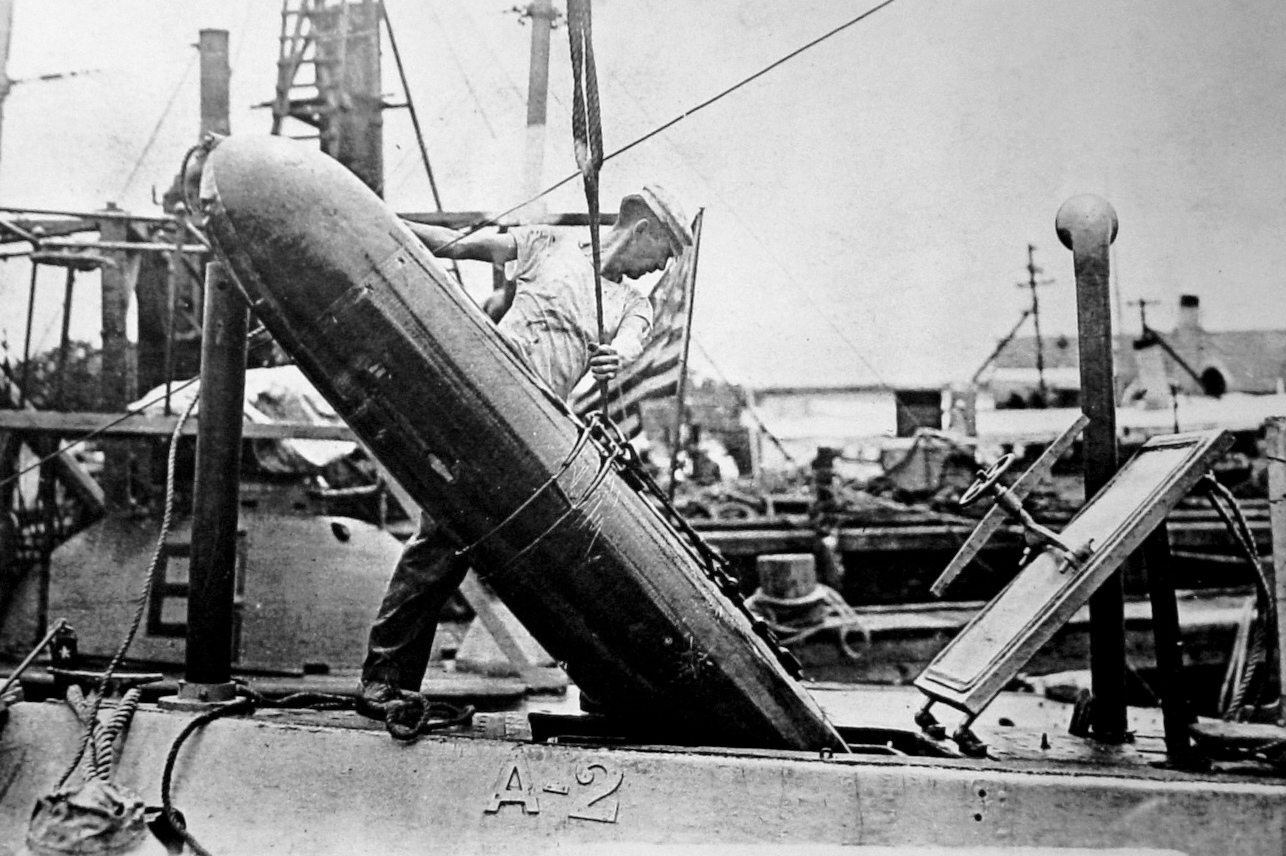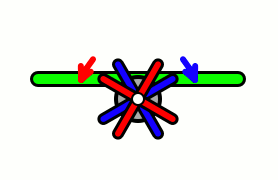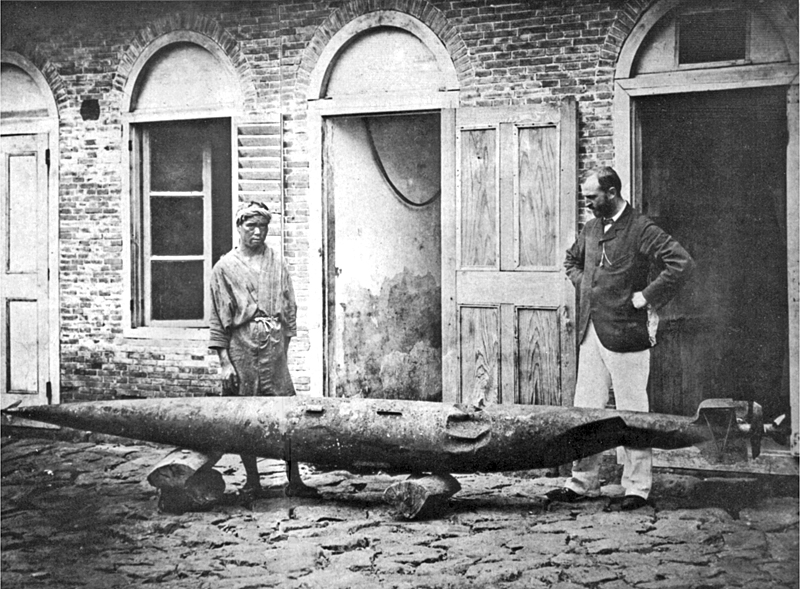|
Bliss-Leavitt Torpedo
The Bliss-Leavitt torpedo was a torpedo designed by Frank McDowell Leavitt and manufactured by the E. W. Bliss Company of Brooklyn, New York. It was put into service by the United States Navy in 1904 and variants of the design would remain in its inventory until the end of World War II. History The E. W. Bliss Company secured manufacturing rights to the Whitehead torpedo in 1892 and thereafter supplied the US Navy with this weapon. In 1904, an engineer with E. W. Bliss, Frank M. Leavitt, designed a torpedo with a "single-stage vertical turbine engine" that utilized compressed air preheated by alcohol. This design became the Bliss-Leavitt Mark 1 torpedo, the first non-Whitehead design after the Howell torpedo. The Mark 1 had a tendency to roll, affecting its directional stability. This was remedied by Lieutenant Gregory C. Davison who proposed a two-stage turbine design that drove contra-rotating propellers. This cancelled the torque effect of the single-stage design, improvin ... [...More Info...] [...Related Items...] OR: [Wikipedia] [Google] [Baidu] |
Anti-surface Warfare
Anti-surface warfare (ASuW or ASUW) is the branch of naval warfare concerned with the suppression of surface combatants. More generally, it is any weapons, sensors, or operations intended to attack or limit the effectiveness of an adversary's surface ships. Before the adoption of the submarine and naval aviation, all naval warfare consisted of anti-surface warfare. The distinct concept of an anti-surface warfare capability emerged after World War II, and literature on the subject as a distinct discipline is inherently dominated by the dynamics of the Cold War. Categories of anti-surface warfare Anti-surface warfare can be divided into four categories based on the platform from which weapons are launched: * Air (or aviation): Anti-surface warfare conducted by aircraft. Historically, this was conducted primarily through level- or dive-bombing, strafing runs or air-launching torpedoes (and in some cases by suicide attacks). Today, air ASuW is generally conducted by stand-off at ... [...More Info...] [...Related Items...] OR: [Wikipedia] [Google] [Baidu] |
Torpedo Boat
A torpedo boat is a relatively small and fast naval ship designed to carry torpedoes into battle. The first designs were steam-powered craft dedicated to ramming enemy ships with explosive spar torpedoes. Later evolutions launched variants of self-propelled Whitehead torpedoes. These were inshore craft created to counter both the threat of battleships and other slow and heavily armed ships by using speed, agility, and powerful torpedoes, and the overwhelming expense of building a like number of capital ships to counter an enemy's. A swarm of expendable torpedo boats attacking en masse could overwhelm a larger ship's ability to fight them off using its large but cumbersome guns. A fleet of torpedo boats could pose a similar threat to an adversary's capital ships, albeit only in the coastal areas to which their small size and limited fuel load restricted them. The introduction of fast torpedo boats in the late 19th century was a serious concern to the era's naval strategists ... [...More Info...] [...Related Items...] OR: [Wikipedia] [Google] [Baidu] |
Robert Whitehead
Robert Whitehead (3 January 1823 – 14 November 1905) was an English engineer who was most famous for developing the first effective self-propelled naval torpedo. Early life He was born in Bolton, England, the son of James Whitehead, a cotton-bleacher, and his wife Ellen Whitehead née Swift. He trained as an engineer and draughtsman, and attended the Mechanics' Institute, Manchester. His first professional employment was at a shipyard in Toulon, France, for Philip Taylor & Sons, and then as a consultant engineer in Milan, Italy. He then moved to Trieste, on the Adriatic coast of Austria. Whitehead's work in Trieste was noticed by the owners of ''Fonderia Metalli'', a metal foundry in the nearby city of Fiume (today Rijeka, Croatia). In 1856, Whitehead became manager of the company, and changed its name to ''Stabilimento Tecnico di Fiume'' (STF). STF produced marine steam boilers and engines, which were the most modern products of that era. The Austrian Navy ... [...More Info...] [...Related Items...] OR: [Wikipedia] [Google] [Baidu] |
The New York Times
''The New York Times'' (''the Times'', ''NYT'', or the Gray Lady) is a daily newspaper based in New York City with a worldwide readership reported in 2020 to comprise a declining 840,000 paid print subscribers, and a growing 6 million paid digital subscribers. It also is a producer of popular podcasts such as '' The Daily''. Founded in 1851 by Henry Jarvis Raymond and George Jones, it was initially published by Raymond, Jones & Company. The ''Times'' has won 132 Pulitzer Prizes, the most of any newspaper, and has long been regarded as a national "newspaper of record". For print it is ranked 18th in the world by circulation and 3rd in the U.S. The paper is owned by the New York Times Company, which is publicly traded. It has been governed by the Sulzberger family since 1896, through a dual-class share structure after its shares became publicly traded. A. G. Sulzberger, the paper's publisher and the company's chairman, is the fifth generation of the family to head the p ... [...More Info...] [...Related Items...] OR: [Wikipedia] [Google] [Baidu] |
Contra-rotating Propellers
Aircraft equipped with contra-rotating propellers, also referred to as CRP, coaxial contra-rotating propellers, or high-speed propellers, apply the maximum power of usually a single piston engine, piston or turboprop engine to drive a pair of coaxial Propeller (aircraft), propellers in contra-rotation. Two propellers are arranged one behind the other, and power is transferred from the engine via a Epicyclic gearing, planetary gear or Gear#Spur, spur gear Transmission (mechanics), transmission. Contra-rotating propellers are also known as counter-rotating propellers, although counter-rotating propellers is much more widely used when referring to airscrews on separate non-coaxial shafts turning in opposite directions. Operation When airspeed is low, the mass of the air flowing through the propeller disk (thrust) causes a significant amount of tangential or rotational air flow to be created by the spinning blades. The energy of this tangential air flow is wasted in a single-prope ... [...More Info...] [...Related Items...] OR: [Wikipedia] [Google] [Baidu] |
Gregory C
Gregory may refer to: People and fictional characters * Gregory (given name), including a list of people and fictional characters with the given name * Gregory (surname), a surname Places Australia *Gregory, Queensland, a town in the Shire of Burke **Electoral district of Gregory, Queensland, Australia *Gregory, Western Australia. United States *Gregory, South Dakota * Gregory, Tennessee *Gregory, Texas Outer space *Gregory (lunar crater) * Gregory (crater on Venus) Other uses * "Gregory" (''The Americans''), the third episode of the first season of the television series ''The Americans'' See also * Greg (other) * Greggory * Gregoire (other) * Gregor (other) * Gregores (other) * Gregorian (other) * Gregory County (other) * Gregory Highway, Queensland * Gregory National Park, Northern Territory * Gregory River in the Shire of Burke, Queensland * Justice Gregory (other) Justice Gregory may refer to: * Georg ... [...More Info...] [...Related Items...] OR: [Wikipedia] [Google] [Baidu] |
Directional Stability
Directional stability is stability of a moving body or vehicle about an axis which is perpendicular to its direction of motion. Stability of a vehicle concerns itself with the tendency of a vehicle to return to its original direction in relation to the oncoming medium (water, air, road surface, etc.) when disturbed (rotated) away from that original direction. If a vehicle is directionally stable, a restoring moment is produced which is in a direction ''opposite'' to the rotational disturbance. This "pushes" the vehicle (in rotation) so as to return it to the original orientation, thus tending to keep the vehicle oriented in the original direction. Directional stability is frequently called "weather vaning" because a directionally stable vehicle free to rotate about its center of mass is similar to a weather vane rotating about its (vertical) pivot. With the exception of spacecraft, vehicles generally have a recognisable front and rear and are designed so that the front points m ... [...More Info...] [...Related Items...] OR: [Wikipedia] [Google] [Baidu] |
Howell Torpedo
The Howell Automobile Torpedo was the first self-propelled torpedo produced in quantity by the United States Navy, which referred to it as the Howell Mark I torpedo. It was conceived by Lieutenant Commander John A. Howell, United States Navy, in 1870, using a 60 kg (130 lb) flywheel spun at a very high speed (10000 to 12000 rpm) to store energy and drive propellers. Design Because it had no complicated engine and fuel system, the Howell was much cheaper and easier to build than its main competitor, the Whitehead. In addition, unlike the Whitehead, the Howell was wakeless, not giving away the position of the firing vessel; its flywheel was, however, very noisy. It did demand a steam turbine to "spin up" the flywheel (a complication inherent to the design). Also unlike the contemporary Whitehead, the Howell kept running in a straight line, due to the gyroscopic effect of the flywheel. A wave coming from one side would tend to roll the Howell rather than deviate it. The ... [...More Info...] [...Related Items...] OR: [Wikipedia] [Google] [Baidu] |
Compressed Air
Compressed air is air kept under a pressure that is greater than atmospheric pressure. Compressed air is an important medium for transfer of energy in industrial processes, and is used for power tools such as air hammers, drills, wrenches, and others, as well as to atomize paint, to operate air cylinders for automation, and can also be used to propel vehicles. Brakes applied by compressed air made large railway trains safer and more efficient to operate. Compressed air brakes are also found on large highway vehicles. Compressed air is used as a breathing gas by underwater divers. It may be carried by the diver in a high pressure diving cylinder, or supplied from the surface at lower pressure through an air line or diver's umbilical. Similar arrangements are used in breathing apparatus used by firefighters, mine rescue workers and industrial workers in hazardous atmospheres. In Europe, 10 percent of all industrial electricity consumption is to produce compressed air� ... [...More Info...] [...Related Items...] OR: [Wikipedia] [Google] [Baidu] |
Turbine Engine
A gas turbine, also called a combustion turbine, is a type of continuous flow internal combustion engine. The main parts common to all gas turbine engines form the power-producing part (known as the gas generator or core) and are, in the direction of flow: * a rotating gas compressor * a combustor * a compressor-driving turbine. Additional components have to be added to the gas generator to suit its application. Common to all is an air inlet but with different configurations to suit the requirements of marine use, land use or flight at speeds varying from stationary to supersonic. A propelling nozzle is added to produce thrust for flight. An extra turbine is added to drive a propeller ( turboprop) or ducted fan (turbofan) to reduce fuel consumption (by increasing propulsive efficiency) at subsonic flight speeds. An extra turbine is also required to drive a helicopter rotor or land-vehicle transmission ( turboshaft), marine propeller or electrical generator (power turbine). Grea ... [...More Info...] [...Related Items...] OR: [Wikipedia] [Google] [Baidu] |
Whitehead Torpedo
The Whitehead torpedo was the first self-propelled or "locomotive" torpedo ever developed. It was perfected in 1866 by Robert Whitehead from a rough design conceived by Giovanni Luppis of the Austro-Hungarian Navy in Fiume. It was driven by a three-cylinder compressed-air engine invented, designed, and made by Peter Brotherhood. Many naval services procured the Whitehead torpedo during the 1870s, including the US Navy. This early torpedo proved itself in combat during the Russo-Turkish War when, on January 16, 1878, the Ottoman ship ''Intibah'' was sunk by Russian torpedo boats carrying Whiteheads, though this story has been disputed in one book. The term "torpedo" comes from the Torpedo fish, which is a type of ray that delivers an electric shock to stun its prey. History During the 19th century, an officer of the Austrian Marine Artillery conceived the idea of using a small boat laden with explosives, propelled by a steam or an air engine and steered by cables to be us ... [...More Info...] [...Related Items...] OR: [Wikipedia] [Google] [Baidu] |
Brooklyn, New York
Brooklyn () is a borough of New York City, coextensive with Kings County, in the U.S. state of New York. Kings County is the most populous county in the State of New York, and the second-most densely populated county in the United States, behind New York County (Manhattan). Brooklyn is also New York City's most populous borough,2010 Gazetteer for New York State United States Census Bureau. Retrieved September 18, 2016. with 2,736,074 residents in 2020. Named after the Dutch village of Breukelen, Brooklyn is located on the western portion of Long Island and shares a border with the borough of Queens. It has several bridge and tunnel connections to the borough of |



.png)



